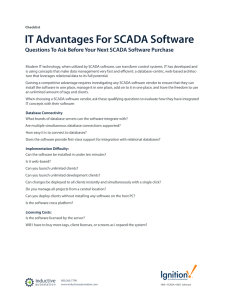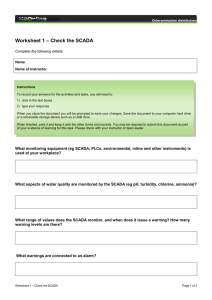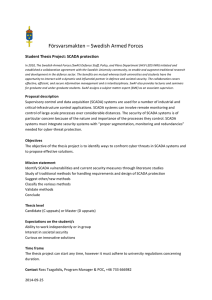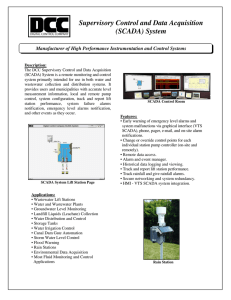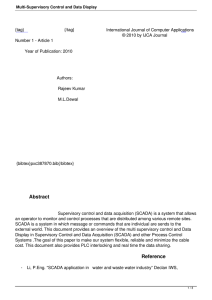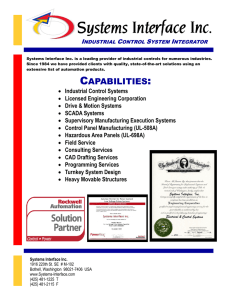SCADA Systems: Supervisory Control & Data Acquisition Overview
advertisement
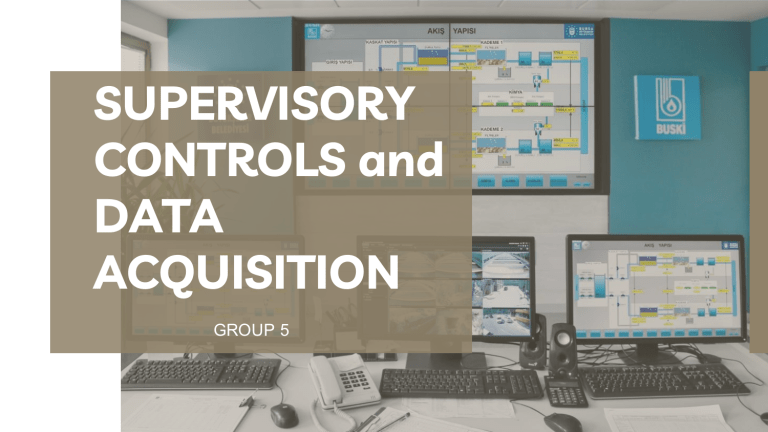
SUPERVISORY CONTROLS and DATA ACQUISITION GROUP 5 What is SCADA? OBJECTIVES of SCADA 4 FUNCTIONS of SCADA 4 MAIN COMPONENTS of SCADA WHO uses SCADA? TABLE OF CONTENTS 01 02 03 04 05 WHAT is SCADA? SCADA stands for “Supervisory Control and Data Acquisition”. SCADA is a type of process control system architecture that uses computers, networked data communications and graphical Human Machine Interfaces (HMIs) to enable a high-level process supervisory management and control. SCADA is a centralized system that monitors and controls the entire area. This supervisory system gathers data on the process and sends the commands control to the process. SCADA systems continuously monitor the physical parameters DATA COMMUNICATION It helps to communicate and transmit a large amount of data between MTU and RTU units MEASURE It measures the parameter for processing CONTROLLING Online real-time monitoring and controlling of the process DATA ACQUISITION It acquires data from RTUs (Remote Terminal Units), data loggers, etc. AUTOMATION It helps for automatic transmission and functionality OBJECTIVES of SCADA MONITOR Data Acquisition Data Presentation The collected data is processed, organized and presented for system operators to make appropriate response and control decisions. The collected data is transmitted either spontaneously or in response to a request for data to some kind of upstream consolidator or master. Control If control decisions are warranted and the system supports output, appropriate commands can be dispatched to affect specific operational or configuration changes. 4 SCADA FUNCTIONS The collection of SCADA data frequently involves some kind of analog to digital conversion. Networked Data Communication INPUT Inputs (either digital or analog) and output relays or electrical signals that directly interface with managed elements in the remote sites. RTUs are small computerized units deployed in the field at specific sites and locations. HMI software is a computer master station system that processes data and allows a human operator to manage and control the system. The communications network is what connects telemetry and SCADA at your remote sites. HUMAN MACHINE INTERFACE (HMI) COMMUNICATIONS NETWORK 4 MAIN COMPONENTS OF SCADA REMOTE TELEMETRY UNITS (RTU) A Basic SCADA Diagram WHO Uses SCADA? SCADA systems are used by industrial organizations and companies in the public and private sectors to control and maintain efficiency, distribute data for smarter decisions, and communicate system issues to help mitigate downtime. An example… SCADA systems can be run virtually, which allows the operator to keep a track of the entire process from his place or control room. Time can be saved by using SCADA efficiently. One such excellent example is, SCADA systems are used extensively in the Oil and Gas sector. Large pipelines will be used to transfer oil and chemicals inside the manufacturing unit. *LAGO, Val B. NORBERTE, Zylah Maye S. BIADO, Debra Fe U. OUR GROUP *ESPIQUE, Anne Mclaine P. THANKS!
